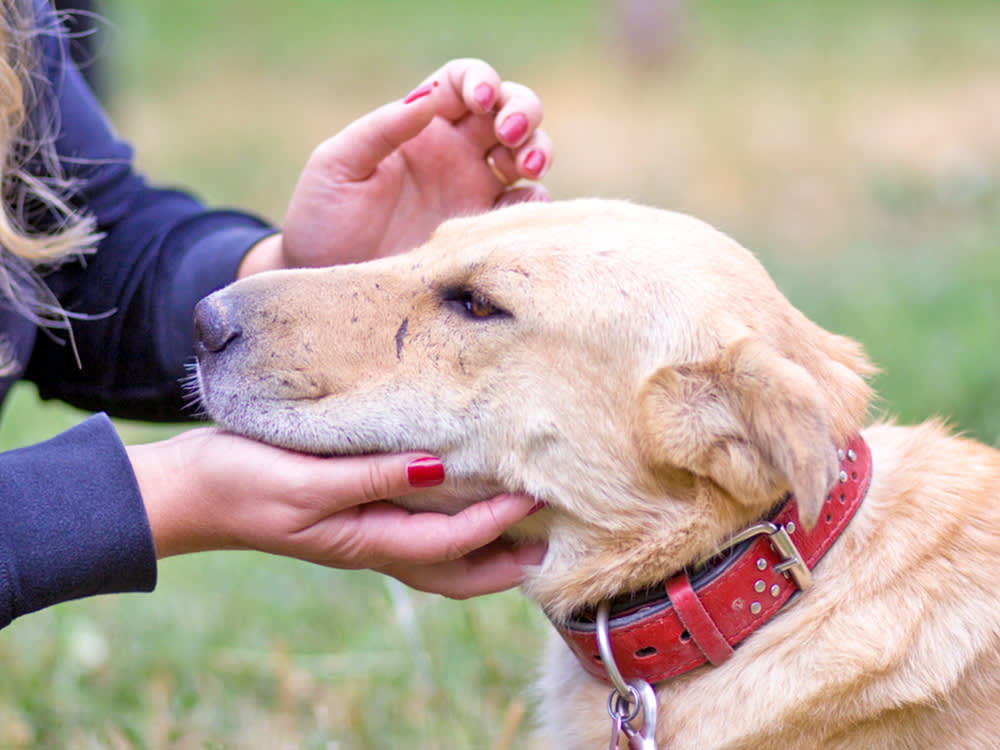Hiker Pulls 24 Ticks off Self and Dog After a 30 Minute Walk
Find out how to safely remove a tick from your pup if you find one (...or more) on them.

Share Article
If you think ticks seem worse this summer, you’re not imagining it. The freaky little bloodsuckers always start making appearances when the weather warms up, but they’re really out of control this year. If you want proof (or nightmare-fuel), look no further than a post by Reddit user Trying_2_Go.opens in new tab “Pulled 24 ticks off me and the dog after a 30 min walk,” the user shared, along with a photo of the two-dozen ticks piled into Tupperware. “I give my dog tick meds monthly, but this is still nerve racking.”
“At this point I would just not go outside,” one user commented. “I think I’d have to move.” Others chimed in with advice on keeping ticks at bays; several jokingly recommended walking with chickens, who they claim are voracious bug eaters, while some commenters touted products like flea collars and Wondercide.opens in new tab
It’s true that there are a lot of great options out there for keeping ticks at bay — and all active pups in tick-infested areas should be on a preventative. But as Trying_2_Go proves, even pet parents who give their dogs monthly tick meds may have to deal with the dreaded creatures in some form or another. And the earlier you address the problem, the better. “Timing is everything in tick removal,” Dr. Aimee Warner, resident veterinarian at Waggel,opens in new tab tells Kinship. “The earlier a tick that is attached is removed, the less time it has to transmit disease. Almost all tick-borne illnesses take 24 to 48 hours of attachment time before they are transmissible, so regular body checking is your best defense.”
Once you spot it, you’ll have to get that sucker (or those suckers, plural, if you’re unlucky) off. Here’s how you can safely remove a tick from a dog.

How to remove a tick from a dog
Acquire a tick-removing tool. Common varieties include grasping tools like tweezers, grasping-and-rotation tools that may be preferable for large ticks, slit tools with V-shaped notches, and slit-and-rotation tools.
Apply gloves before attempting to remove the tick. This helps prevent disease transmission from the tick. “Find the tick and gently brush aside the hair around it to look straight where the tick is stuck in the skin,” Dr. Warner says.
The manufacturer of your tick removal tool will probably provide specific removal instructions; be sure to follow those closely. If one is provided, watch an instructional video. “Grasp straight up with even, firm pressure,” Dr. Warner recommends. “Don’t jerk or twist the tick, as this may cause the mouth parts to be left in the skin. The tick should be pulled out whole.”
Disinfect the bite area and wash your hands.
It sounds weird, but it can be useful to keep the tick. “Store the tick in an airtight container with date and location on dog’s body where you initially found it — this comes in useful if your dog presents symptoms later,” Dr. Warner says. This is also a method of disposing of the tick safely, without crushing the tick (which could spread disease) or allowing it back into the environment. If you aren’t able to store the tick, you can put it in rubbing alcohol or wrap it tightly in tape.
Tick-removal myths and “don’t”s
Don’t use Vaseline, heat or fire, nail polish, or alcohol to remove a tick from your dog — these are all common tick-removal myths that aren’t the best option. “None of these methods work every time and might even prompt the tick to regurgitate into your dog's blood, possibly increasing disease transmission risk,” Dr. Warner says.
If the mouth of the tick remains lodged in the dog’s body (gross, we know), don’t worry — and don’t try to remove it. “The mouth parts are unable to be disease-causing by themselves, and they will usually take care of themselves normally or leave a small bump which will heal by itself,” Dr. Warner says. Attempting to dig around for these pieces could make things worse and risks spreading any tick-borne disease.
Keep an eye out for tick-borne disease symptoms
Even after removing the tick, be sure to monitor your dog for symptoms of tick-borne disease. Dogs are often able to fight off tick-borne diseases on their own, but they can occasionally become sick. Symptoms vary depending on the type of tick but may include limping, changes in eating habits, fever, joint swelling, and fatigue. If your dog shows any signs of poor health or behavioral changes after a tick bite, get them medical attention immediately.
“Above all, don’t wait to get veterinary care if your dog has any abnormal reactions after a tick bite, even if the tick appeared to be removed successfully,” Dr. Warner says. “The key here is early treatment with tick-borne illnesses, and your veterinarian will recommend whether preventive therapy is indicated based on your geographical location and the specific tick involved.”

Sio Hornbuckle
Sio Hornbuckle is the Assistant Editor at Kinship, where they frequently write for the site. As a writer, they specialize in pet news, animal science, and pop culture. They live in New York City with their cat, Toni Collette.
Related articles
![Veterinarian checking large dog's skin and fur.]()
Vet-Recommended Flea-and-Tick Treatments
Learn what is best for your pet.
Should You Give Your Dog a Summer Haircut?
For some breeds, it may do more harm than good.
![Black Lab playing in creek]()
Why Your Dog Should Stay Far, Far Away From Blue-Green Algae This Summer
Consider getting a water-testing kit to keep your pup safe.
![Australian Shepherd on a hill during golden hour]()
How to Hike Safely With Your Dog This Summer
Time to get your gear—and your pup—ready to go.
![Black lab swimming in pool]()
How to Keep Your Dog Safe Wherever They’re Swimming This Summer
In the pool, a lake, a river, or the ocean.
![Dog laying outside in the sunshine.]()
12 Surprising Things Dogs Hate About Summer
Not everyone appreciates a Summer Friday.





